
An image of a luxury Rolls-Royce logo as an example of a Veblen good.
Veblen Goods Explained
Definition
Veblen goods refer to a type of luxury goods that consumers think reflect a posh lifestyle. Veblen goods become more desirable as the price of these goods increases. Veblen goods are considered a status symbol and are targeted towards the wealthy and status-conscious consumers of a society.
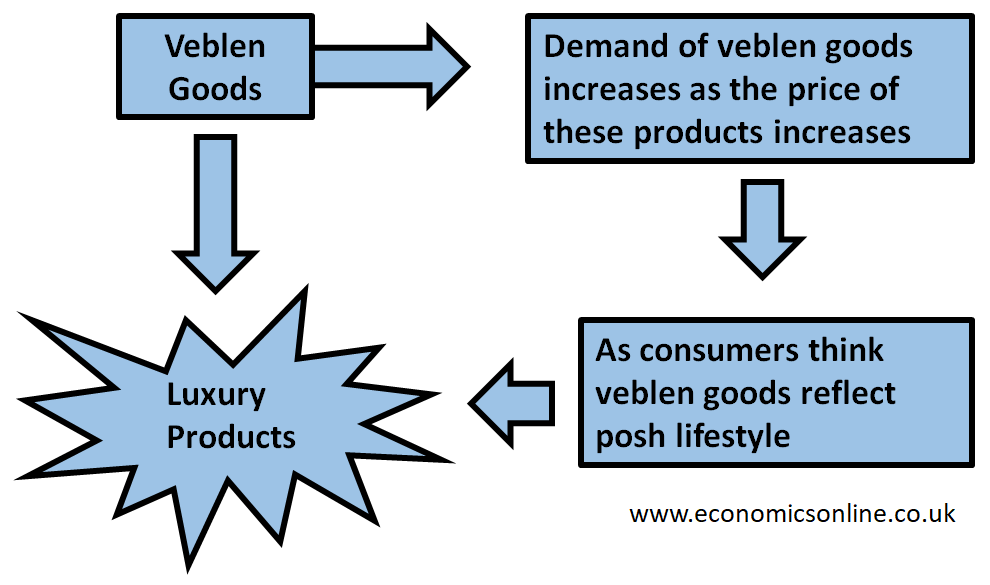
Veblen goods are identified by American economist Thorstein Veblen in his book “The Theory of the Leisure Class”, published in 1899.
Examples
Examples of Veblen goods are luxury cars, branded or designer clothes, luxury watches and diamond jewellery. Veblen goods have an upward sloping demand curve, in which as price increases, the quantity demanded of Veblen goods increases, and vice versa. The demand for Veblen goods is influenced by psychological factors such as social status, social comparison, consumption, etc.
Normal Goods
Definition
Normal goods are a common type of goods that consumers purchase. The normal goods demand curve is sloping downward, and if price of normal goods increases, the quantity demanded of these goods decreases. The demand for normal goods increases as income increases.
Examples
Examples of normal goods are houses, clothes, electronics, phones, vacations, and other non-luxury products.
Demand Curve for Normal Goods
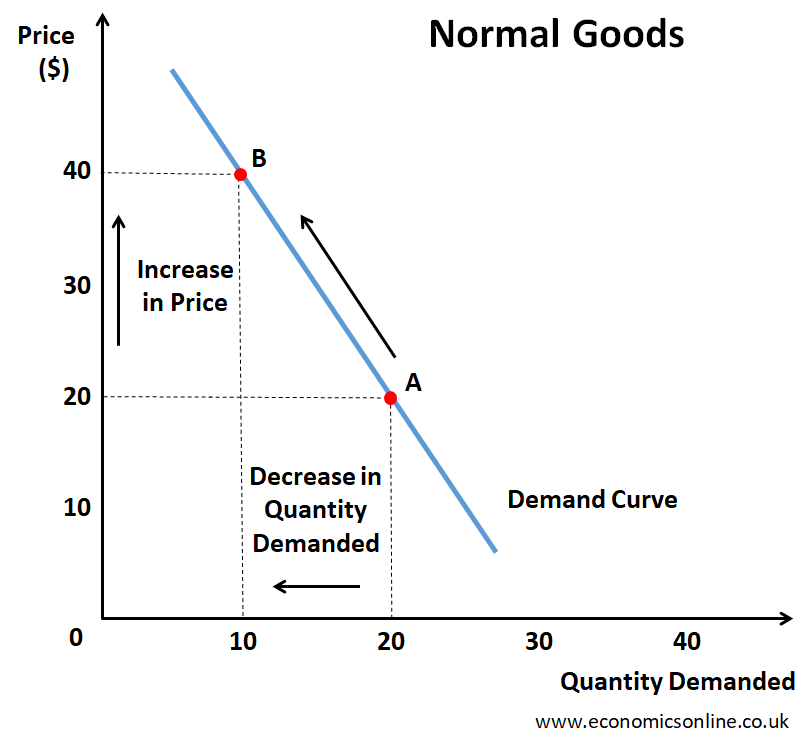
Normal goods show a downward sloping demand curve, which explains that as the prices of normal goods increases, the quantity demanded decreases. In this graph, we have the quantity demanded on the x-axis and the prices of normal goods on the y-axis. When we increase the prices of these goods, the quantity demanded decreases. This will result in a downward-slopping demand curve showing a decline. The downward sloping demand curve illustrates the inverse relationship between price and quantity demanded.
Demand Curve for Veblen Goods
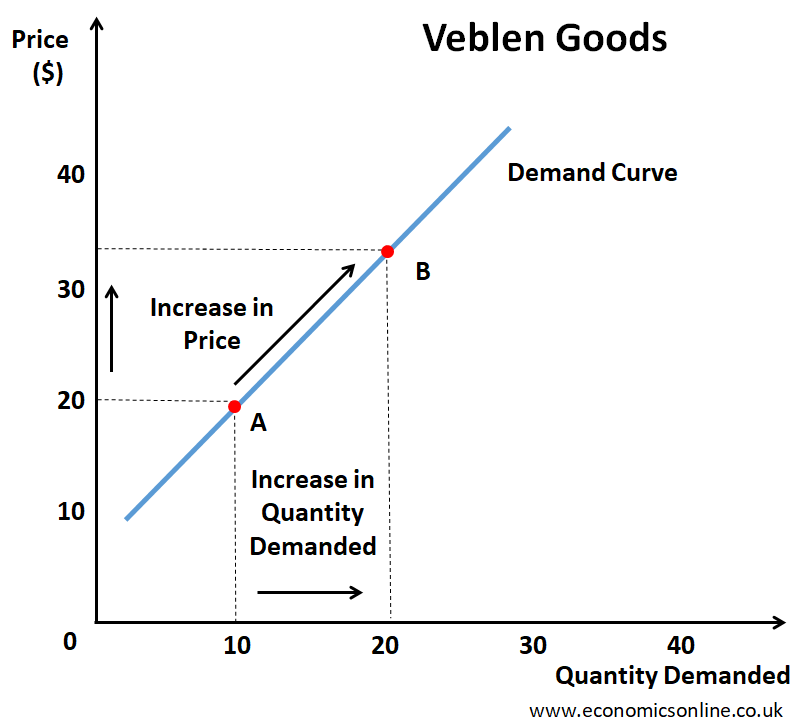
In this graph, we have the quantity demanded on the x-axis and the prices on the y-axis. As the price of Veblen goods increases, the quantity demanded of these goods increases. The prices and quantity demanded of Veblen goods are directly related to each other, resulting in an upward-slopping demand curve. People with a luxury lifestyle prefer to purchase Veblen goods to showcase their posh lifestyle. The demand for Veblen goods increases with the increase in prices, and vice versa.
Veblen Goods and the Law of Demand
Veblen goods are considered as the exceptions of the basic law of demand. This is because their demand curve does not follow the downward sloping pattern. Rather, the demand curve for Veblen goods is upward sloping which suggests the positive or direct relationship between the price and the quantity demanded of these goods.
Types of Veblen Goods
The following are the types of Veblen goods, which are:
Luxury Cars
High-end automobiles (expensive cars like Rolls-Royce) that showcase prestige and exclusivity.
Designer Clothing
Fashion items from luxury brands that convey status and style.
High-end Jewellery
Exquisite pieces made with precious metals and gemstones.
Exclusive Real Estate Properties
Luxury homes and properties in desirable locations.
Premium Brand Accessories
Accessories like handbags, watches, and sunglasses from renowned luxury brands.
The Veblen Effect
The Veblen effect is a phenomenon in which the demand for luxury goods increases as the price increases. People perceive Veblen goods as more valuable because of their high prices. The high prices of these goods create a sense of curiosity and status.
For example, when Gucci releases limited stock in the market at high prices, people rush to buy these products to showcase their wealth and posh lifestyle.
Causes of the Veblen Effect
The following are some causes of Veblen goods, which are as follows:
Social status
Veblen goods are associated with high social status. People buy Veblen goods to showcase their wealth and social status in a society.
Conspicuous Consumption
The act of visibly consuming luxury goods (expensive products) can be perceived as a display of a person’s wealth and posh lifestyle, leading to a desire to purchase luxury goods.
Exclusivity
Limited availability of Veblen goods or high prices can create a perception of exclusivity, making Veblen goods more desirable.
Peer Influence
People may be influenced by their social circles or relations with the elite class to purchase Veblen goods in order to fit in with or keep up with the lifestyle of those around them.
Aspirational Consumption
People may aspire to attain a higher social status and believe that owning valuable goods will help them achieve that goal.
The Snob Effect
In economics, the snob effect is a phenomenon in which people prefer goods or experiences over those they perceive as exclusive or rare. The snob effect happens when people buy luxury brand items just to showcase their high social status.
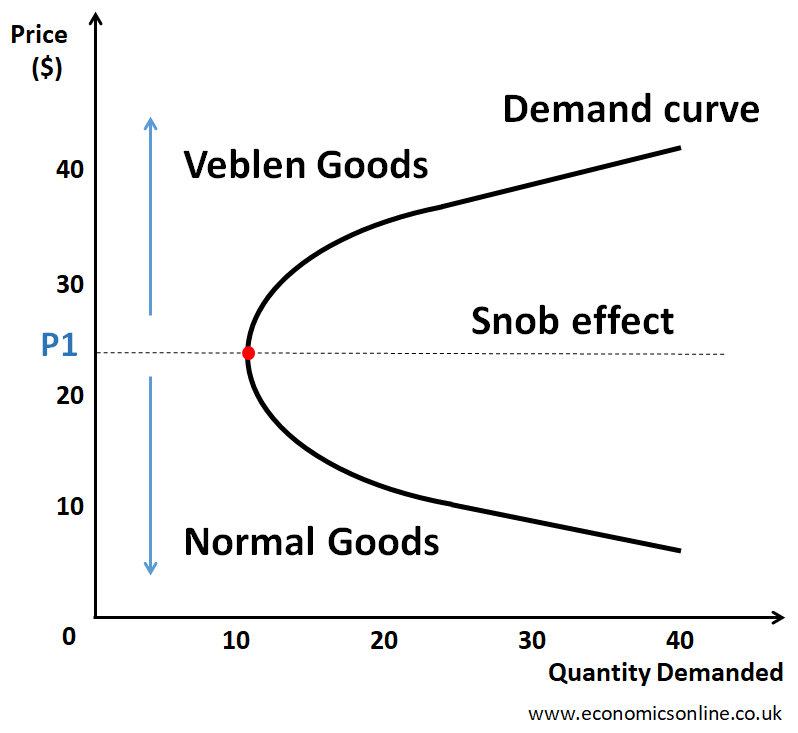
The graph explains the snob effect in the context of Veblen goods and normal goods. The snob effect can be seen with the help of the demand curve. In this graph, the quantity demanded is on the x-axis, and the prices are on the y-axis. When the prices of products are below the point P1, the quantity demanded moves in the opposite direction of the price change. At these prices, the products are considered normal goods, and people want to buy them due to their low prices. When the prices of products rise above the point P1, the quantity demanded of these goods also rises. At these prices, the products are considered as Veblen goods, and people prefer to buy them to showcase their posh lifestyle and social status.
The Bandwagon Effect
The bandwagon effect is a phenomenon in which people follow or adopt the same trend as other people are doing so. For example, people use a particular social media platform just because everyone else is using it such as WhatsApp, Messenger or Facebook. The major example of the bandwagon effect is the Tiktok app, where people set a trend to make Tiktok videos and use this app.
The Network Effect
The network effect is a phenomenon in which the value or consumption of products or services increases as more people use them. The network effect is like how social media platforms become more valuable as more people join them which create a large network and interaction between them.
The Common Law of Business Balance
The common law of business balance is the principle that, in order to be successful, businesses need to strike a balance between various factors such as demand and supply, costs and revenue, risk and reward, and consumer satisfaction.
Normal and Inferior Goods
Normal goods are the types of products or services for which the demand for products or services increases as the income of individuals increases. When the income of individuals increases, the demand for normal goods increases (higher demand) because people are more willing to buy products.
Inferior goods are the types of products or services for which demand for these products decreases as income increases. When the income of individuals increases, they prefer to shift their needs or interests towards higher quality goods rather than spend money on inferior goods. For example, if a person’s income increases, they might start buying more organic food (better quality) rather than buying from generic brands.
Veblen Goods vs. Giffen Goods
The following table compares the main features of Veblen goods and Giffen goods including the income effect, the substitution effect. It also has some examples of Giffen goods including wheat, rice and other essential goods.
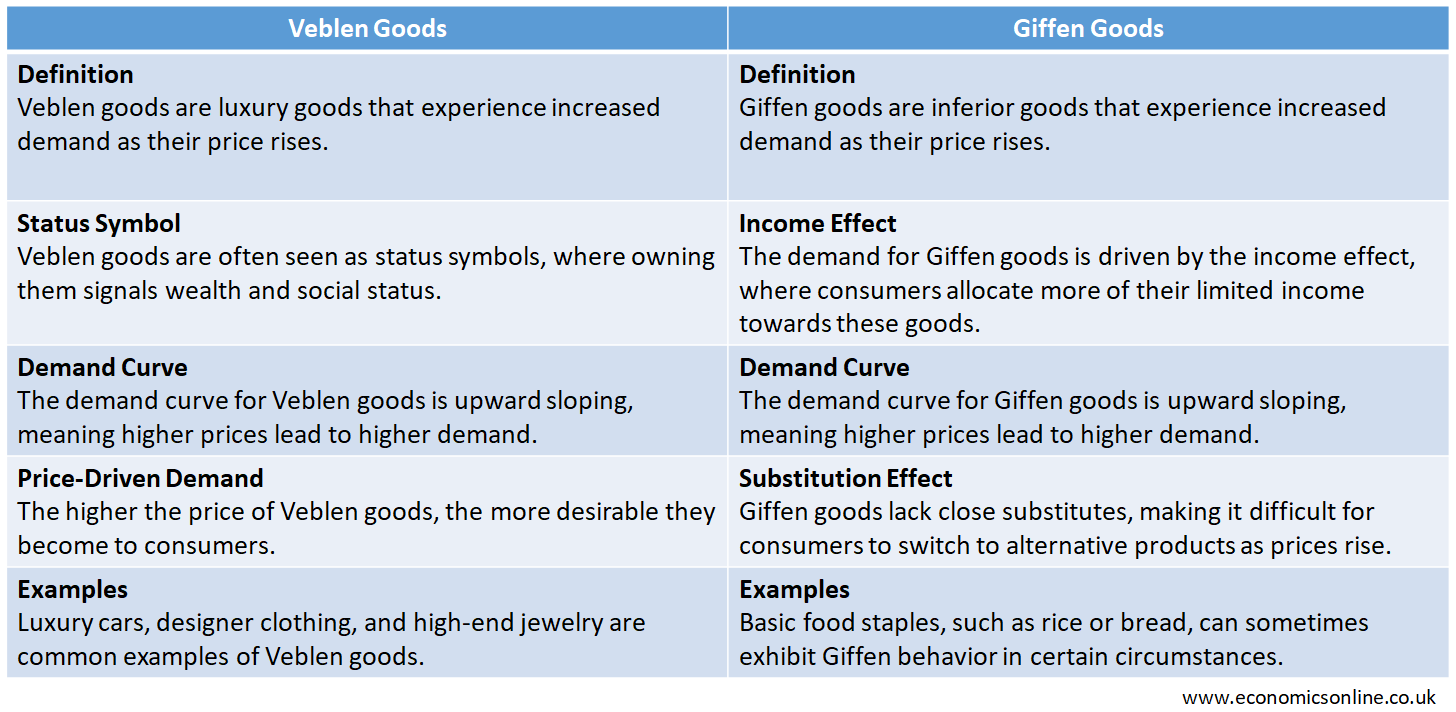
Characteristics of Veblen Goods
The following are some major characteristics of Veblen goods, which are as follows:
Status Symbol
High social status is associated with Veblen goods, as these goods are seen as a symbol of wealth and a posh lifestyle.
Price-dependent Demand
Like other goods, the quantity demanded of Veblen goods increases, as the price of these products increases. People are more willing to buy Veblen goods at a higher price because of their posh lifestyle.
Limited Quantity
Brands produce goods in limited stock because their brand’s strategy is to attract more buyers who rush to buy goods when they hear the word limited stock. That’s why Veblen goods are produced in limited quantities.
Branding and Reputation
Veblen goods are associated with well-known luxury brands that have a strong reputation for high-quality and exclusivity.
Social Influence
Social factors affect the demand for Veblen goods. These social factors might include the desire to fit in with a certain social group or to display their richness and success.
Target Market for Veblen Goods
The target market for makers of Veblen goods is composed of typical individuals who value luxury, social status, and exclusivity. The people who prefer Veblen goods are willing to pay a premium for products that are seen as prestigious and desirable. Veblen goods target niche market instead of a mass market.
Disadvantages of Veblen Goods
The following are some major disadvantages of Veblen goods:
High Cost
Veblen goods are so expensive that they are not affordable for many consumers. High costs affect the demand for Veblen goods. It decreases the quantity demanded for many products.
Artificial Scarcity
Artificial scarcity is also a disadvantage of Veblen goods because the limited availability of Veblen goods creates artificial scarcity, which causes higher prices and exclusivity.
Shifting Trends
The shifting trends and preferences also negatively affect the demand for Veblen goods, making them less desirable over time.
Potential Overemphasis on Materialism
The desire to own luxury items leads to an overemphasis on material possessions and social status, affecting other important aspects of life.
Exclusivity and Exclusion
Veblen goods contribute to a sense of exclusivity and exclusion (social division), as not every individual can afford or access them.
Conclusion
In conclusion, Veblen goods are bought by people to satisfy their status needs. These Veblen goods are discussed in microeconomics as an exception of the law of demand. It is important to consider the factors affecting demand for Veblen goods. It is also important to decide whether Veblen goods are associated with personal values and priorities. The desire to have Veblen goods is based on the individual’s desirability, preferences, and circumstances.


